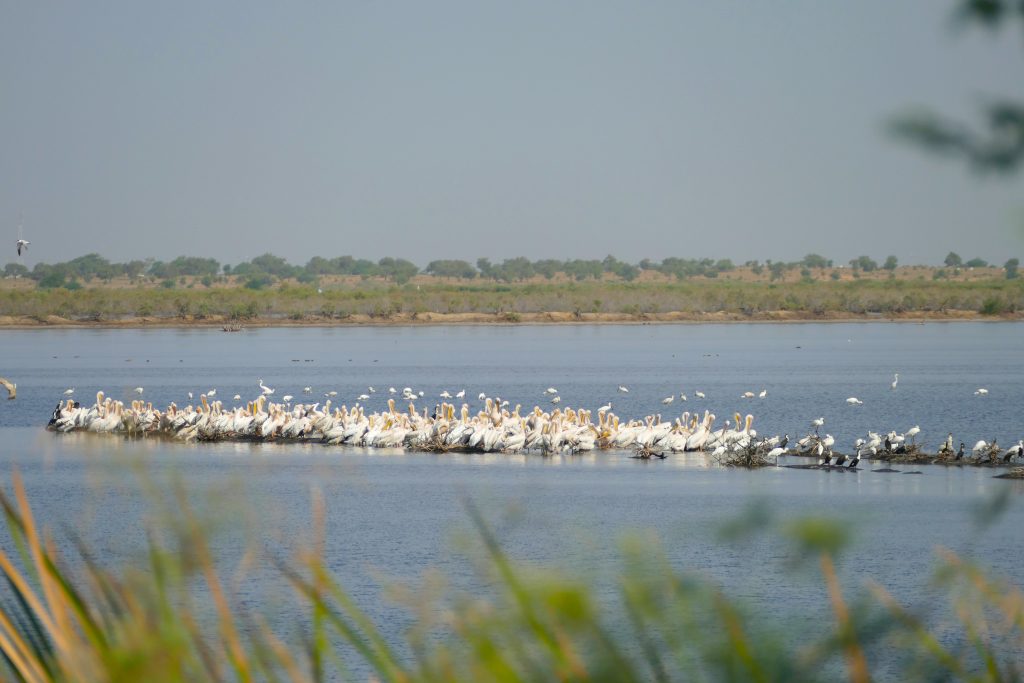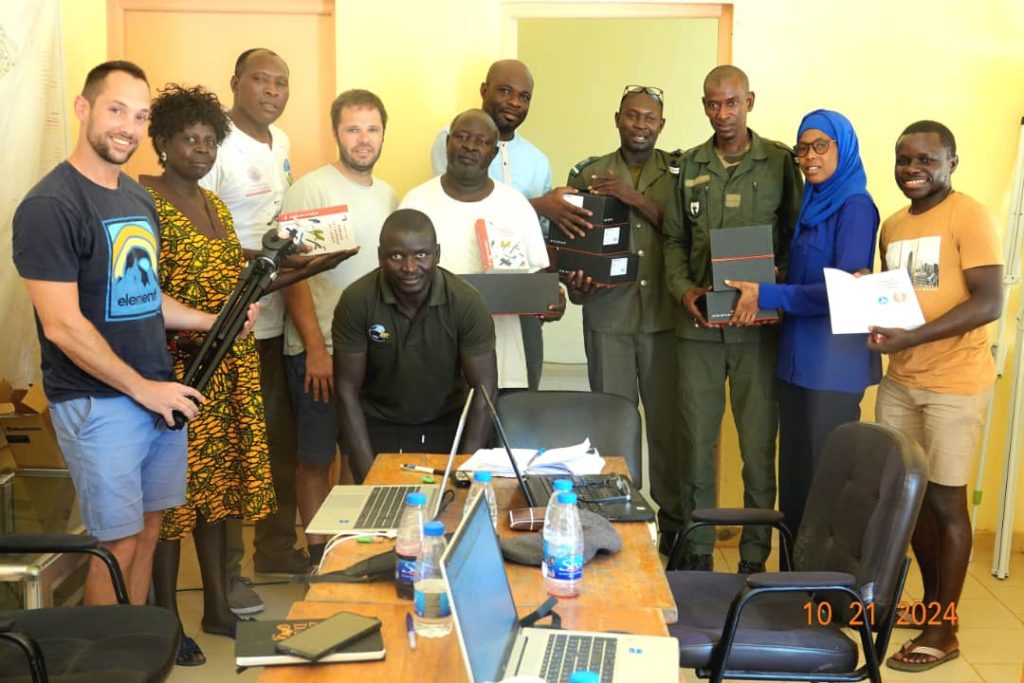In Senegal, local communities are protecting critical sites while improving their livelihoods

With over 560 bird species, including nearly 250 migratory ones, Senegal is a critical haven for avian biodiversity.
By Amadou Diallo
With its many protected areas of international importance such as Djoudj National Park, the world’s third-largest bird wintering grounds, and Saloum Delta National Park, the largest Royal Tern breeding colony with an estimated of a minimum of 40,000 pairs, Senegal hosts a significant diversity of birds. Over 560 species have been counted, with about 248 of them migratory including the black-tailed godwit (Limosa limosa), Osprey (Pandion haliaetus), Eurasian teal (Anas crecca), and Garganey (Spatula querquedula) among others. However, these protected areas are under threat from agricultural development and urbanization, pollution and climate change among others.
“Due to its unique location along the East Atlantic Flyway, a major migratory route for birds stretching from Iceland to South Africa, and in light of various threats to these birds, there is need for collaborative conservation action in key protected areas to ensure that species thrive along the eastern flyway” says Geofroy Citegeste, the East Atlantic Flyways Initiative (EAFI) Manager.
Since 2022, BirdLife Partner, Nature Communautés Développement (NCD) has been implementing the AGIR (Support for integrated resource management in Senegal) Project. Financed by Agence Française de Développement (AFD) through Ligue pour la Protection des Oiseaux (LPO), the project aims at strengthening bird conservation initiatives along the EAFI through capacity building of institutions and local communities involved in conservation, ecological monitoring, and improving community livelihoods around four protected areas including Tocc Tocc Nature Reserve (270 Ha), Kalissaye Nature Reserve (30000 Ha), Palmarin Reserve (10430 Ha), and the Kusmar Island Reserve (300 Ha) the largest West African breeding ground for the Lesser Kestrel
As part of capacity building efforts, the project has trained over 100 people including reserve managers, civil society organizations and local communities, on various aspects including :data collection and KBA/IBA assessment, bird monitoring, site management, ecotourism based fundraising, and the use of TESSA Toolkit for Ecosystem Service Site-based Assessment to assess and value these crucial benefits (ecosystem services) at these sites.
“These trainings have come at just the right time. Protected area management authorities have made considerable efforts to recruit new staff who need to be trained in various areas of conservation, especially around the new concepts like KBAs/IBAs, TESSA ect. This project has responded to this need” notes Colonel Pathé Baldé, Manager of the Kalissaye Ornithological Reserve
Further, the project is supporting ecological monitoring at these key sites through bird monitoring programs. It is worth noting that these activities are being implemented at bird wintering sites with a total of nearly 400 species recorded at these sites.
At Kusmar Island Reserve, two species including the Lesser Kestrel and the Scissor-tailed Kite have been monitored to understand threats and adopt appropriate conservation measures. To support these monitoring activities, 30 pairs of binoculars, 6 telescopes and 20 bird identification books were distributed. It is planned to continue this monthly bird monitoring beyond the project, and the results will be used to feed international databases such as Geonature and World Bird/Biodiversity Database.
“Noting the importance of Kumsar Island Reserve, it is critical to monitor this habitat. The project has been instrumental in providing much needed equipment to support this monitoring”, says Gueye Dieye a Site manager at Kumsar Island Reserve
Through this monitoring, the 170km2 Lake Guiers IBA in northern Senegal, an important water source in the country is in the process of being evaluated, and the results will be shared with indigenous communities to encourage their greater commitment to its conservation. At the same time, a policy brief is being developed by both NCD and BirdLife Policy team aimed at national authorities to prompt urgent measures. This document will be shared at various national and international conferences, particularly at Ramsar COP 15 in July 2025, to showcase the wetland conservation approach developed through the AGIR project.
Appreciating the role of local communities in biodiversity conservation, the AGIR project is linking biodiversity conservation to the economic development of communities around protected areas. This is being realized through conservation friendly income generating activities. benefitting more than 8000 local community members at the four sites. To this end, two ecotourism circuits have been identified and are being promoted at each site to increase the incomes of eco-guides, hoteliers and local community members
At each site, a local microenterprise has been selected to receive training, formalization and equipment support. In the Kalissaye and Palmarin Reserve, the focus is on processing and value addition to forest products, including Detarium senegalensis (Sweet detar), a leguminous tree prized for its fruit, medicinal properties and timber, Senegal Saba (Africa Cherry) valued for its fruit, in addition to salt mining.
“Harvesting the fruits of the detarium tree is one of the activities most practiced by the local population. During the harvest period, women from various groups work with reserve managers to ensure that the tree is harvested sustainably. The income gotten from processing the fruit into various types of juices, has enabled us to take care of our daily needs and our children’s education. In addition, local community members are more involved in conservation efforts, thanks to the project’s TESSA training” says Louise Sarr, president of the Palmarin Women Group.
In the Tocc-tocc Reserve, focus has been on the removal of Typha (an invasive weed), in 50 ha of the reserve, converting it into biofuel briquettes, and mats. In March 2025, a Typha briquettes processing unit was installed in the Reserve. This will be followed by training of community members on the use of the machinery, before production begins.

Further, the project is supporting the economic valuation of Gowe (Senegalese Incense) in the reserve, with a view of setting up an optimal valorisation system to enable processing of various products including traditional room fragrance with high economic value.
“This support for the benefit of communities around protected areas, makes us self-sufficient, thus enabling us to participate in conservation efforts”, says Babacar Lo, a member of the Tocc-Tocc Nature Reserve Management Committee.
As the projects draws to a close in 2025, it is envisaged that bird monitoring will go beyond the first phase of the project, in addition to the development of identified ecotourism circuits and provision of equipment to identify businesses at the sites. In future, the project will aim to expand capacity building initiatives in three countries including Guinea, Mauritania and Côte d’Ivoire. Further, the project will aim to expand Partnerships with other organizations specializing in income-generating activities, to better combine local development and biodiversity conservation, while developing business models that leverage the potential of each site.
“This project is a real tool for strengthening partnerships for the benefit of bird conservation and improving livelihoods for local communities. Training in various aspects, particularly in ecosystem value assessment, will enable us to forge alliances with local communities to build a strong advocacy for conservation”, concludes Ramatoulaye Diallo, NCD’s Head of Conservation.
Header Image: Snapshot of birds at on a lake at Tocc Tocc reserve © LPO





This project is a real tool for strengthening partnerships for the benefit of bird conservation and improving livelihoods for local communities.
Ramatoulaye Diallo, Head of Conservation, at NCD







Noting the importance of Kumsar Island Reserve, it is critical to monitor this habitat. The project has been instrumental in providing much needed equipment to support this monitoring.
Gueye Dieye, Site manager at Kumsar Island Reserve



